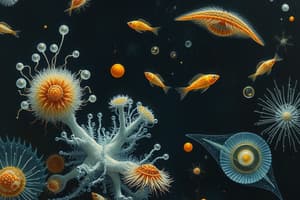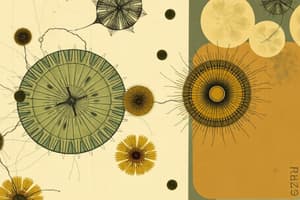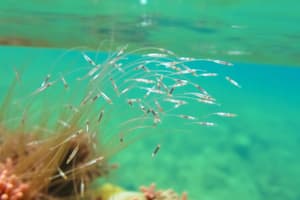Podcast
Questions and Answers
Marine organisms are classified according to ______ they live and how they move.
Marine organisms are classified according to ______ they live and how they move.
where
Organisms that inhabit the water column can be classified as being______.
Organisms that inhabit the water column can be classified as being______.
Plankton, Nekton, Benthos
Plankton are also known as ______.
Plankton are also known as ______.
Drifters
______ includes all organisms - algae, animals, and bacteria - that drift with ocean currents.
______ includes all organisms - algae, animals, and bacteria - that drift with ocean currents.
Many _____ can swim but either move only weakly or move only vertically. As such, they cannot determine their horizontal position within the ocean.
Many _____ can swim but either move only weakly or move only vertically. As such, they cannot determine their horizontal position within the ocean.
_____ are highly abundant and incredibly important within the marine environment.
_____ are highly abundant and incredibly important within the marine environment.
Most of Earth's biomass - the mass of living organisms - consists of _____ adrift in the oceans.
Most of Earth's biomass - the mass of living organisms - consists of _____ adrift in the oceans.
Even though _____% of marine species are bottom-dwelling, the vast majority of the ocean's biomass is planktonic.
Even though _____% of marine species are bottom-dwelling, the vast majority of the ocean's biomass is planktonic.
_____ are classified based on their feeding styles.
_____ are classified based on their feeding styles.
Autotrophs; undergo photosynthesis, can range in size from microscopic algae to larger species of drifting kelp.
Autotrophs; undergo photosynthesis, can range in size from microscopic algae to larger species of drifting kelp.
Heterotrophs; includes drifting marine animals.
Heterotrophs; includes drifting marine animals.
Free-living bacteria; more abundant and widely distributed than previously thought; incredibly small (0.00002 inch); some are so small they can be removed only with special microfilters.
Free-living bacteria; more abundant and widely distributed than previously thought; incredibly small (0.00002 inch); some are so small they can be removed only with special microfilters.
Smaller than bacterioplankton; composed principally of bacteriophages and algal viruses, can have a significant impact on bacteria and unicellular algae populations.
Smaller than bacterioplankton; composed principally of bacteriophages and algal viruses, can have a significant impact on bacteria and unicellular algae populations.
_____ are surprisingly abundant in marine ecosystems; can strongly influence the structure of marine food webs by limiting the abundance of other types of plankton through infection and lysis.
_____ are surprisingly abundant in marine ecosystems; can strongly influence the structure of marine food webs by limiting the abundance of other types of plankton through infection and lysis.
Although ______ are classified according to their feeding styles, they can also be classified according to the portion of their life cycle spent as plankton.
Although ______ are classified according to their feeding styles, they can also be classified according to the portion of their life cycle spent as plankton.
Organisms that spend their entire lives as plankton are called ______.
Organisms that spend their entire lives as plankton are called ______.
Many organisms that spend their adult lives as nekton or benthos but spend their juvenile and/or larval stages as plankton are called ______.
Many organisms that spend their adult lives as nekton or benthos but spend their juvenile and/or larval stages as plankton are called ______.
Plankton can also be classified according to their ______.
Plankton can also be classified according to their ______.
Large floating animals and algae, such as jellies and Sargassum are called _____ and measure 2 to 20 centimeters (0.8 to 8 inches).
Large floating animals and algae, such as jellies and Sargassum are called _____ and measure 2 to 20 centimeters (0.8 to 8 inches).
Nekton are also known as _____.
Nekton are also known as _____.
_____ includes all animals capable of moving independently of the ocean current by swimming or other means of propulsion.
_____ includes all animals capable of moving independently of the ocean current by swimming or other means of propulsion.
_____ are capable not only of determining their own positions within the ocean but also, in many cases, of long migrations.
_____ are capable not only of determining their own positions within the ocean but also, in many cases, of long migrations.
______ includes most adult fish, marine mammals, marine reptiles, and some marine invertebrates such as squid.
______ includes most adult fish, marine mammals, marine reptiles, and some marine invertebrates such as squid.
When you swim in the ocean, you become ______, too!
When you swim in the ocean, you become ______, too!
Even though they move freely, many _____ are unable to move throughout the breadth of the ocean.
Even though they move freely, many _____ are unable to move throughout the breadth of the ocean.
Gradual changes in temperature, salinity, viscosity, and availability of nutrients effectively limit ______ lateral range.
Gradual changes in temperature, salinity, viscosity, and availability of nutrients effectively limit ______ lateral range.
Changes in water pressure normally limit the vertical range of _____ .
Changes in water pressure normally limit the vertical range of _____ .
_____ range in size from tiny krill (2 inches) to the blue shark (13 or so feet).
_____ range in size from tiny krill (2 inches) to the blue shark (13 or so feet).
Benthos are also known as _____ .
Benthos are also known as _____ .
_____ describes organisms living on or in the ocean bottom.
_____ describes organisms living on or in the ocean bottom.
There are 3 types of benthos: _____ .
There are 3 types of benthos: _____ .
_____ live on the surface of the sea floor, either attached to rocks or moving along the bottom.
_____ live on the surface of the sea floor, either attached to rocks or moving along the bottom.
_____ live buried in the sand, in discarded shells, or within the mud that exists on the sea bottom.
_____ live buried in the sand, in discarded shells, or within the mud that exists on the sea bottom.
_____ live on the bottom yet also have the ability to swim or crawl through the water above the ocean floor (octopi, crabs, and sea urchins).
_____ live on the bottom yet also have the ability to swim or crawl through the water above the ocean floor (octopi, crabs, and sea urchins).
The _____ coastal ocean floor contains a wide variety of physical and nutritive conditions, which have allowed a great number of animal species to develop.
The _____ coastal ocean floor contains a wide variety of physical and nutritive conditions, which have allowed a great number of animal species to develop.
When moving across the bottom from the shore into deeper water, the NUMBER of benthos species per square meter may remain relatively constant, but the _____ of benthos organisms decreases.
When moving across the bottom from the shore into deeper water, the NUMBER of benthos species per square meter may remain relatively constant, but the _____ of benthos organisms decreases.
_____ sea floor areas receive sufficient sunlight, so they can support many species of large marine algae (often called seaweed) that are attached to the bottom.
_____ sea floor areas receive sufficient sunlight, so they can support many species of large marine algae (often called seaweed) that are attached to the bottom.
Throughout most of the _____ parts of the sea floor, animals live in perpetual darkness, where photosynthetic production cannot occur. They must feed on each other or whatever nutrients fall from the upper photic zone.
Throughout most of the _____ parts of the sea floor, animals live in perpetual darkness, where photosynthetic production cannot occur. They must feed on each other or whatever nutrients fall from the upper photic zone.
The _____ sea bottom is an environment of coldness, stillness, and darkness. Life progresses slowly and organisms that live here are widely distributed because physical conditions vary little on the deep-ocean floor, even over great distances!
The _____ sea bottom is an environment of coldness, stillness, and darkness. Life progresses slowly and organisms that live here are widely distributed because physical conditions vary little on the deep-ocean floor, even over great distances!
Flashcards are hidden until you start studying
Study Notes
Marine Organism Classification
- Marine organisms are classified based on their habitat and movement.
- Key classifications include Plankton, Nekton, and Benthos.
Types of Plankton
- Plankton, also known as drifters, drift with ocean currents and include algae, animals, and bacteria.
- Plankton are abundant and crucial in marine environments, making up most of Earth's biomass.
- Approximately 98% of marine species are bottom-dwelling, yet the majority of ocean biomass consists of plankton.
Plankton Categories
- Plankton can be classified by feeding style:
- Autotrophs (phytoplankton): Perform photosynthesis and range in size from microscopic algae to large kelp.
- Heterotrophs (zooplankton): Include drifting marine animals.
- Bacterioplankton: Free-living bacteria that are extremely small and abundant in marine environments.
- Virioplankton: Composed mainly of bacteriophages and algal viruses; play a role in influencing plankton populations.
Life Cycle and Classification
- Plankton can be categorized by the duration spent in the planktonic stage:
- Holoplankton: Organisms living their entire lives as plankton.
- Meroplankton: Organisms that are plankton only during juvenile or larval stages, such as squid.
Size Classification of Plankton
- Plankton may also be categorized based on size, such as macroplankton, which includes larger floating organisms measuring 2 to 20 centimeters.
Nekton Overview
- Nekton, or swimmers, includes all marine animals that can move independently of currents, such as fish, marine mammals, and some invertebrates.
- Nekton are capable of navigation and long migrations, but their movement is often limited by environmental conditions like temperature and pressure.
Benthos Overview
- Benthos, known as bottom dwellers, inhabit the ocean floor and include three types:
- Epifauna: Organisms living on the surface of the sea floor.
- Infauna: Organisms that burrow into the sand or mud.
- Nektonbenthos: Organisms that live on the bottom but can swim or crawl.
Ecosystems and Environments
- Shallow coastal areas of the ocean floor support diverse species of large marine algae (seaweed) due to adequate sunlight.
- As depth increases, biomass of benthos organisms may decrease, while the number of species per square meter remains constant.
- Deeper ocean floors are cold, dark, and stark, with organisms dependent on nutrients from upper layers, leading to a slower life pace.
Studying That Suits You
Use AI to generate personalized quizzes and flashcards to suit your learning preferences.




